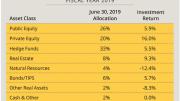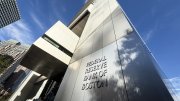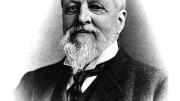Harvard achieved its sixth consecutive budget surplus—some $298 million, up from $196 million in the prior year—according to the University’s annual financial report for the fiscal period ended June 30, 2019, published in late October. The surpluses realized from fiscal 2014 through the most recent year now total $769 million—the happy result of the proceeds from the $9.62 billion Harvard Campaign, a continued benign U.S. economic environment, and internal spending restraint. That cushion—surely the envy of other institutions of higher education—provides some protection against economic or financial adversity, and creates flexibility in paying for the continuing campus construction boom. It may also serve as a bridge during the multiyear effort to strengthen the performance of the endowment, the foundation of the University’s economic model. The accompanying report from Harvard Management Company (HMC) indicates both the magnitude of underperforming endowment assets, and the time it will take to reinvest the portfolio in pursuit of hoped-for enhanced returns.
Budget Highlights
Revenue increased nearly $300 million to about $5.5 billion (up 5.7 percent), in part reflecting slightly less stern restraints on distributions from the endowment, Harvard’s largest source of revenue (35 percent of the total). Expenses rose by almost $200 million, to $5.2 billion (3.9 percent). President Lawrence S. Bacow’s introductory letter acknowledged the evident strength, but cautioned that “we, along with all of our colleagues in higher education, must be conscious of the challenges of our current climate,” including an inevitable end of the economic expansion; the new federal taxes on university endowments (for which Harvard made an estimated $50-million provision in fiscal 2019); and uncertain federal funding for research.
Digging a bit deeper, student income totaled $1.2 billion. Given continued torrid growth in executive- and continuing-education revenues (up 12 percent), this is now a half-billion-dollar business, a distinguishing feature of Harvard’s operations compared to peer institutions. Those fees now essentially equal revenue (net of financial aid) from all undergraduate and graduate degree programs. The endowment distribution rose nearly $90 million (4.7 percent), to a bit more than $1.9 billion: a Corporation-approved 2.5 percent increase per unit owned by each school, plus growth reflecting earnings and distributions from new gifts (emanating from The Harvard Campaign and subsequent philanthropy). A similar 2.5 percent increase per endowment unit owned is budgeted for the current fiscal year, plus incremental distributions from gifts and other additions to the endowment. Sponsored research revenue rose modestly to $937 million, with federal grants weaker than those from foundations, corporations, and individuals.
In part, Harvard got lucky in fiscal 2019. Continuing and executive education was more robust than anticipated. Current-use giving, expected to tail off after the campaign, in fact increased modestly, as a large payment to fulfill a pledge came in at year-end. And there was a large royalty payment for the use of intellectual property.
About half of expenses are for compensation. Wages and salaries rose 4.9 percent, accelerating from fiscal 2018, reflecting pay increases and additional employees—many of them on term agreements related to research funding, or in growth areas like continuing and executive education. Employee-benefits costs appear to have decreased. In fact, benefits for active employees are being constrained by higher deductibles and coinsurance put in place in recent years; retiree costs have been lower than expected; and an annual accounting adjustment this year had the effect of reducing the reported expense.
Capital spending totaled $903 million—on pace with the record $908 million in fiscal 2018 and $906 million the prior year. The University expected to have to borrow to pay for all the large projects under way (Lowell House renewal is complete, and Adams House is under way; the Allston science and engineering complex comes into use by the fall semester of 2020), but the large, cumulative surpluses (and depreciation, now nearly $400 million per year) may provide sufficient room to stave off any resort to the debt markets. That is especially so if the building boom subsides: many current projects stem from the capital campaign, which is now well in the rearview mirror.
But not every faculty is in equally favorable circumstances. The School of Engineering and Applied Sciences (SEAS) faces substantially higher operating expenses in occupying the huge Allston quarters next year, raising questions—as yet unanswered—about how that burden will be divvied up between the University and the school. And the Faculty of Arts and Sciences’ (FAS) annual financial statement revealed that it has been authorized to spend $960 million so far on House renewal, a sum that will apparently take it through perhaps one-third of the Adams House work. Extrapolating, completion of Adams might bring the bill to $1.1 billion to $1.2 billion, for about 1.05 million gross square feet of space: an indication of just how costly it is to do high-quality renovation, in tight quarters, in Boston’s pricey construction market. FAS is incurring substantial new debt to pursue the work—with the enormous Eliot and Kirkland House projects potentially looming over its budget later in the decade, posing hard choices about investing in faculty growth and new research priorities. Inevitably, that points to future fundraising (not least, to repurpose and re-equip the spaces SEAS will quit in Cambridge).
In that vein, Harvard continues to enjoy astonishing philanthropic support. Beyond the continued strength in current-use giving, even after the end of the campaign, pledges for future current-use gifts increased nearly $200 million. And even as past pledges for endowment gifts continue to be fulfilled, the balance for such pledges receivable increased by nearly $600 million in fiscal 2019, suggesting several major gifts in the pipeline, at least. An accounting change somewhat bolstered this year’s report, but the salient fact is that total pledges receivable increased by more than $900 million—after the Harvard Campaign.
On balance, the surpluses and pledge pipeline are obvious strengths in a uncertain, volatile world. Harvard’s costs will rise as expensive new facilities open, financial aid increases, researchers need more equipment and computing to conduct their work—and the Graduate Student Union negotiations likely result in enhanced compensation for that large cohort of workers. And of course University leaders are mindful that the endowment, now valued at $40.9 billion, represents little, if any, appreciation in inflation-adjusted terms from the pre-financial-crisis level of $36.9 billion in 2008—a period during which Harvard’s expenses have increased by about $1.5 billion.
The Endowment
In his report, HMC chief executive N.P. Narvekar explained the substantial deployment of endowment assets that has taken place during the first two-plus years of his restructuring of the organization, its personnel, and their investment strategies. He also detailed some of the painful costs of effecting those changes:
Some $1 billion of natural-resources assets were written down or written off in fiscal 2017, with a further $100 million of write-downs in fiscal 2019—plus sales of $1.1 billion of such holdings, with another $200 million designated for sale. Even so, remaining natural-resources assets produced a return of -7 percent this past year, and they and other “illiquid anchors” will continue to weigh on performance.
And a significant volume of private-equity, real-estate, and other assets, totaling perhaps $1 billion, has been sold, with other miscellaneous holdings written down or written off, again depressing returns.
Looking forward, at what he believes is the halfway point of HMC’s transformation, Narvekar intends to invest significantly in private equity. The asset class has, historically, delivered superior returns, so HMC’s relative under-investment in such assets has penalized endowment performance. But there is no quick fix. “Early in my time,” he wrote, “we modeled it to take 7-9 years to attain a meaningfully higher allocation to private equity in a prudent manner”: selecting the right fund managers, diversifying investments by maturity, and being patient during an “aggressive valuation environment.” That suggests another five to six years to achieve a targeted endowment allocation, and a subsequent multiyear period to harvest the results. In the meantime, HMC and the University are also deep into an exploration of Harvard’s risk tolerance and the appropriate investment allocation and portfolio construction to achieve it.
* * *
This is a long game, with crucial implications for the future fulfillment of Harvard’s academic mission. The institution is fortunate to pursue it fortified with operating surpluses and the support of dedicated, generous supporters. For detailed analysis of the financial and endowment reports, see harvardmag.com/financial-endowment-reports-19.









